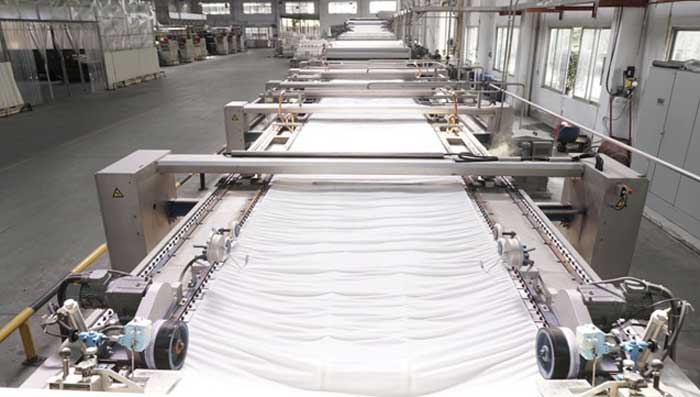
Open-width wet processing for knit fabric: A fast-emerging trend
Goller stands out as the pioneer in developing open-width knit fabric mercerising ranges.
Sustainability has emerged as a pivotal concern globally and the textile industry is no exception. Ecology and energy conservation are now focal points as much as quality and price.
Presently, knit textiles are predominantly processed in a tubular form. However, the demand for open-width processing is on the rise. The Indian knit processing industry is increasingly recognising the significant advantages of open-width knit fabric processing with respect to quality and savings of water and energy. This is clear from the ongoing trend wherein several processors have integrated open-width knit processing into their existing tubular knit processing setups.
Challenges faced with tubular knit fabric processing
- Inconsistent results due to batch process
- Poor fabric surface quality due to aggressive handling
- High weight loss
- High chemical and dye consumption
- High effluent loads
- High fabric handling necessitates increased dependency on labour
A.T.E. offers complete solutions for Goller open-width knit fabric wet processing machines from Fong’s National Engineering Co: German technology made in China. Goller offers spun oil washing ranges, bleaching ranges, mercerising ranges, cold pad batch dyeing, and washing ranges for dyed and printed knit fabrics in open form. Goller has established itself as a world leader for knit open-width wet processing with hundreds of successful installations worldwide. Goller’s success with open-width knit fabric processing stems from their modular design tailored to meet specific customer requirements that result in optimum results for the application.
Various modules offered by Goller
Here are list of modules Goller is offering to the industry;
- Oxidator washer a drum washer module with driven fabric transport and power spray for sensitive fabrics which requires dwell time for swelling and shrinkage
- Sintensa washer a drum washer module with an inner propeller for effective washing with high turbulence
- Universa conveyors compartment with bath separation and circulation spraying system for maintaining dwell time
- Variety of chemical dosing systems based on application along with flow control
- 45° angle intermittent squeezer with scroll roll opening to prevent edge curling thereby avoiding crease formation or pressing
- Auto filtering systems
- Elastodip chemical applicator, with a long dwelling time of 2-3 minutes for good chemical exchange before bleaching steamer
- Special S–wrap mangle for higher pickup of chemicals
- A fabric reaction steamer with a built-in indirect steam generation system manages saturated steam conditions and a 100 degrees C+/-1 temperature. It includes tension-controlled drums for fabric preheating, roller or conveyor bed transport for dwell time, E+L centering, and double scroll roll at exit
- In mercerising, specially designed roller section as impregnation compartment for dry on wet or wet on wet, room/hot mercerisation, auto caustic concentration control +/-0.5Be, st. upper roller and bottom rollers with load cell tension control in each section, pin chain with 4-5 sections (12-15m), width adjustment at each section, followed by tension-controlled washing and PH neutralisation results in best quality mercerisation
- All the washers, except dwell time zones, have thermplate heating systems for effective and efficient heat transfer for energy conservation and reducing the water level in the compartment
Advantages of open-width knit processing over tubular fabric processing
The open-width knit processing features several enhancements including improved surface quality, reduced loss of weight and tensile strength, less pilling, excellent colour appearance, minimised shrinking, lower production costs, decreased effluent loads, a clean department environment, and consistency in results.

Soft flow machine material to liquor ratio: 1:5, fabric width 2.2 m
Though the mercerising process has been an integral part of woven fabric processing to produce high-quality fabric, this was not available for knits in open-width form due to the challenges involved in handling knit fabrics in open form. Goller stands out as the pioneer in developing open-width knit fabric mercerising ranges and till date, they have installed 15 machines worldwide, including the one in India at PC Colours, Kolkata.
Mercerising helps to improve dye affinity which invariably leads to 15 to 20 per cent dye savings, provides a deeper shade and more lustrous appearance, achieves excellent colour especially medium dark or dark, and improves the brightness after printing
Similarly, the cold pad batch dyeing method for reactive dyeing of cotton fabrics yields good dyeing results with lower effluent loads. Colour fixation in CPB dyeing is better compared to the exhaust method, requires less water for washing, reduced TDS of the effluent as no salt is used, and consumes no steam for dye fixation.
A.T.E.: a perfect partner for you
A.T.E. has always been dedicated to offering state-of-the-art, efficient, and eco-friendly equipment that helps customers gain a competitive advantage. The concepts of responsibility and technology are part of the values of A.T.E.
Apart from supplying a complete package of machinery for the processing industry, A.T.E. offers after-sales services, technological support, AMCs, machine audits, etc. A.T.E. has also successfully executed many green-field projects.
A.T.E. is a one-window solution provider in textile engineering across the textile value chain, backed by 80+ years of experience and deep domain knowledge. That is why in addition to textile machinery, we also offer state-of-the-art effluent treatment plants with IoT monitoring, sludge handling solutions and ZLD.




